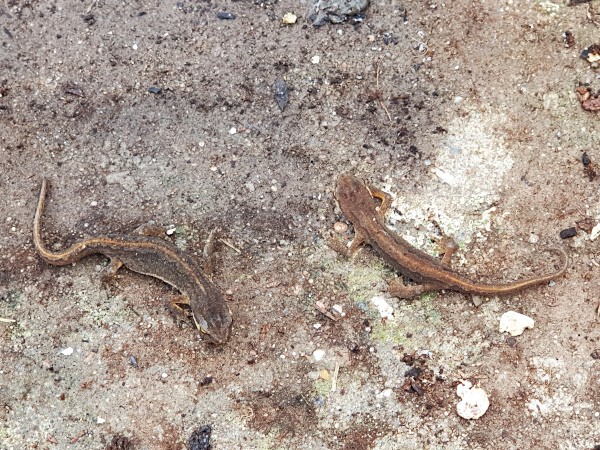Hoglets and other Wildlife
Monday 22nd June 2020

Hoglet
In June, Nick (my husband) nearly stepped on a baby hedgehog (hoglet) when he was pegging out the washing. We were surprised. At first we thought it was dead but closer inspection showed it was breathing.
We thought it might be like baby birds where you are supposed to leave them alone and the mother will come and find it. We now know this is not the case.
We covered it with a small, open ended, cardboard box, to keep it warm, and went inside to ask the Internet. When we came out again, the little thing had crawled out of the box and was joined by two siblings. All crawling about, with their eyes shut, looking for their mother. Unfortunately there was no sign of her.

Three Hoglets on their way to the Rescue Centre
We rang the Havenmore Hedgehog Rescue centre near Newtown in Powys and these were the steps she told us to take.
1. Examine each hedgehog carefully for fly’s eggs, they look like tiny grains of rice. Brush these off (we used a soft toothbrush). If you don’t do that the eggs will hatch and burrow into the hoglet and will eat them from the inside. It is called Fly Strike and can happen very quickly, within a couple of hours.
2. Put a hot water bottle in a box, cover it with a towel and place the hoglets on top. Cover them over with another towel.
3. Take them to the rescue centre.
Sadly one of them didn’t make it, but the other two thrived and were eventually released into a foster carer’s garden where they were fed extra food to bulk them up for winter.
So in summary if you find hoglets out in the daytime it is likely the mother has gone. Clean off any fly’s eggs, keep them warm and take them to a sanctuary immediately.

Toad
In other wildlife, we found this warty little chap when we were planting up the bank at the back of the house. It’s the common toad, Latin name Bufo bufo. I was surprised to see it in such a dry location, but it seemed happy enough. We covered it back over with soil and avoided planting near it.

Frog
We have a pond in the garden, it actually used to be a ford at the bottom of the drive but the ford was dammed to form a natural pond complete with two resident moorhens. The pond means we have hundreds of frogs not just around the pond but throughout the garden.
This is a common frog I found at the base of the rockery wall, proving that nowhere is really dry on a hillside in Wales.

Newts
We have seen both smooth newts and crested newts. The crested newt was larger, almost black with black markings. These are two smooth newts I disturbed when I moved a pot. Cute as pie

Rush hour in Mid Wales
This constitutes rush hour where we live. A male pheasant with a bevy of female pheasant beauties or maybe juveniles, I’m not sure.
We feed all the birds in winter including any pheasants that turn up. In return the blue tits stripped the earwigs out of my dahlias within a couple of days of them turning up to chow down on the petals.
We also have buzzards and red kites flying over the garden and last summer I saw a pied flycatcher in the woodland and a nightingale perched on a post by the lawn. It didn’t stay for long; I think it was on its way to somewhere else. In early summer we hear cuckoos.
All this is mind bending for a girl brought up in Birmingham who has never lived in the countryside. How lucky are we?
Other Blogs
- The Start of the Journey (18th August 2019)
- The Making of a Flower Farm (14th May 2020)
- Hoglets and other Wildlife (22nd June 2020)
- Polytunnel Preparation (15th October 2020)
- Building a Polytunnel on a Slope (14th November 2020)
- Making a Dried Flower Wreath (18th December 2020)
- Sowing Sweet Peas (27th December 2020)
- Organising Seeds (2nd March 2021)
- In Love with the Lent Lily (20th March 2021)
- Tulip Exotic Emperor (25th April 2021)
- Keeping Snapdragons Straight (9th September 2021)

